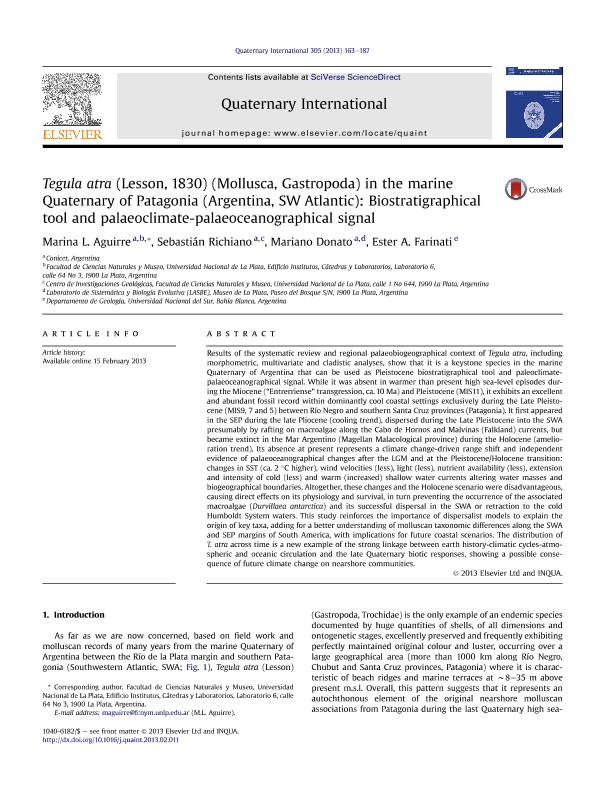Mostrar el registro sencillo del ítem
dc.contributor.author
Aguirre, Marina Laura

dc.contributor.author
Richiano, Sebastian Miguel

dc.contributor.author
Donato, Mariano Humberto

dc.contributor.author
Farinati, Ester Amanda

dc.date.available
2017-06-12T15:28:41Z
dc.date.issued
2013-02
dc.identifier.citation
Aguirre, Marina Laura; Richiano, Sebastian Miguel; Donato, Mariano Humberto; Farinati, Ester Amanda; Tegula atra (Lesson, 1830) (Mollusca, Gastropoda) in the marine Quaternary of Patagonia (Argentina, SW Atlantic): Biostratigraphical tool and palaeoclimate-palaeoceanographical signal; Elsevier; Quaternary International; 305; 2-2013; 163-187
dc.identifier.issn
1040-6182
dc.identifier.uri
http://hdl.handle.net/11336/17972
dc.description.abstract
Results of the systematic review and regional palaeobiogeographical context of Tegula atra, including morphometric, multivariate and cladistic analyses, show that it is a keystone species in the marine Quaternary of Argentina that can be used as Pleistocene biostratigraphical tool and paleoclimate-palaeoceanographical signal. While it was absent in warmer than present high sea-level episodes during the Miocene (“Entrerriense” transgression, ca. 10 Ma) and Pleistocene (MIS11), it exhibits an excellent and abundant fossil record within dominantly cool coastal settings exclusively during the Late Pleistocene (MIS9, 7 and 5) between Río Negro and southern Santa Cruz provinces (Patagonia). It first appeared in the SEP during the late Pliocene (cooling trend), dispersed during the Late Pleistocene into the SWA presumably by rafting on macroalgae along the Cabo de Hornos and Malvinas (Falkland) currents, but became extinct in the Mar Argentino (Magellan Malacological province) during the Holocene (amelioration trend). Its absence at present represents a climate change-driven range shift and independent evidence of palaeoceanographical changes after the LGM and at the Pleistocene/Holocene transition: changes in SST (ca. 2 °C higher), wind velocities (less), light (less), nutrient availability (less), extension and intensity of cold (less) and warm (increased) shallow water currents altering water masses and biogeographical boundaries. Altogether, these changes and the Holocene scenario were disadvantageous, causing direct effects on its physiology and survival, in turn preventing the occurrence of the associated macroalgae (Durvillaea antarctica) and its successful dispersal in the SWA or retraction to the cold Humboldt System waters. This study reinforces the importance of dispersalist models to explain the origin of key taxa, adding for a better understanding of molluscan taxonomic differences along the SWA and SEP margins of South America, with implications for future coastal scenarios. The distribution of T. atra across time is a new example of the strong linkage between earth history-climatic cycles-atmospheric and oceanic circulation and the late Quaternary biotic responses, showing a possible consequence of future climate change on nearshore communities.
dc.format
application/pdf
dc.language.iso
eng
dc.publisher
Elsevier

dc.rights
info:eu-repo/semantics/openAccess
dc.rights.uri
https://creativecommons.org/licenses/by-nc-sa/2.5/ar/
dc.subject
Tegula
dc.subject
Biostratigraphy
dc.subject
Paleoclimatology
dc.subject
Paleooceanography
dc.subject.classification
Paleontología

dc.subject.classification
Ciencias de la Tierra y relacionadas con el Medio Ambiente

dc.subject.classification
CIENCIAS NATURALES Y EXACTAS

dc.title
Tegula atra (Lesson, 1830) (Mollusca, Gastropoda) in the marine Quaternary of Patagonia (Argentina, SW Atlantic): Biostratigraphical tool and palaeoclimate-palaeoceanographical signal
dc.type
info:eu-repo/semantics/article
dc.type
info:ar-repo/semantics/artículo
dc.type
info:eu-repo/semantics/publishedVersion
dc.date.updated
2017-06-08T19:48:42Z
dc.journal.volume
305
dc.journal.pagination
163-187
dc.journal.pais
Países Bajos

dc.journal.ciudad
Amsterdam
dc.description.fil
Fil: Aguirre, Marina Laura. Universidad Nacional de la Plata. Facultad de Ciencias Naturales y Museo; Argentina. Consejo Nacional de Investigaciones Científicas y Técnicas; Argentina
dc.description.fil
Fil: Richiano, Sebastian Miguel. Consejo Nacional de Investigaciones Científicas y Técnicas. Centro Científico Tecnológico Conicet - La Plata. Centro de Investigaciones Geológicas. Universidad Nacional de la Plata. Facultad de Cs.naturales y Museo. Centro de Investigaciones Geológicas; Argentina
dc.description.fil
Fil: Donato, Mariano Humberto. Universidad Nacional de la Plata. Facultad de Ciencias Naturales y Museo; Argentina
dc.description.fil
Fil: Farinati, Ester Amanda. Universidad Nacional del Sur. Departamento de Geología; Argentina
dc.journal.title
Quaternary International

dc.relation.alternativeid
info:eu-repo/semantics/altIdentifier/url/http://www.sciencedirect.com/science/article/pii/S1040618213000839
dc.relation.alternativeid
info:eu-repo/semantics/altIdentifier/doi/http://dx.doi.org/10.1016/j.quaint.2013.02.011
Archivos asociados
